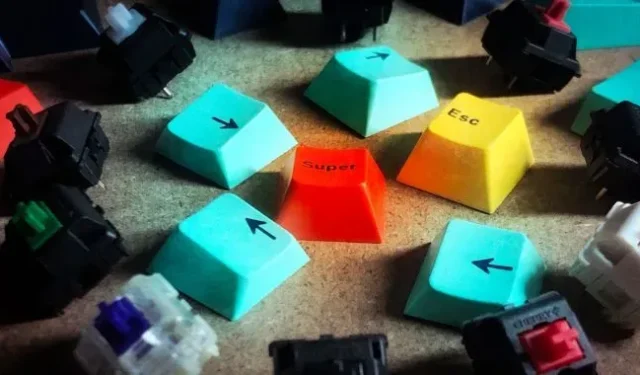So you’ve heard of mechanical keyboards and want to learn more.
Sure, a standard membrane keyboard will do the job, but the durable keys and signature tactile feel of mechanical keyboards offer a top-notch experience that many people trust. If you’ve ever noted with dismay the “softness”of a keyboard, a mechanical keyboard might be just what you need.
Each key in a mechanical keyboard has its own switch, and in order to register input, the plastic rod inside the switch must be pushed down, with resistance coming from the switch’s spring. In contrast, membrane keyboards (also known as rubber dome keyboards) use thin layers of plastic under the keys. Pressing a key sends the dome through a hole in the membrane, creating a circuit and sending the input to the PC. While membrane keyboards tend to be thinner, quieter, more water resistant, and cheaper to make, they can appear flat and make it difficult to tell if you’ve pressed a key or not. Mechanical switches provide a lot of physical feedback.
This is not surprising, given the fact that mechanical keyboards are close descendants of typewriters, providing a distinctive, affirmative tactility with every keystroke. IBM’s spring-loaded switch, patented in 1977, largely laid the foundation for today’s mechanical switches. And in the 1980s, Cherry patented its first mechanical switches, introducing different types of feel and movement that are still being used, imitated and reimagined.
But buying a mechanical keyboard is not that easy. There are different sizes, switches, keycaps and functions. Not to mention the jargon – what do half of these words even mean? This is enough to give up even the most determined buyer.
Whether you need a primer, a refresher, or a handy guide to show interested newbies, we’re here to help. Below, we will tell you what you should know before buying a mechanical keyboard.
Let’s click.
Mechanical keyboard dimensions
The first thing to determine is what size keyboard you need.
You might consider a smaller keyboard if you have limited desk space, need extra mouse space, need something portable, or simply prefer a tidier look. Some enthusiasts claim that a smaller keyboard helps provide a more ergonomic fit, as you can keep your hands close to your body while using all the keys.
Some keyboards take liberties with traditional layouts. And you can find niche products in between, like the “50 Percent Keyboard”. When in doubt, you can look at the pictures to make sure the keyboard has the keys you need.
Here is a summary of the most common mechanical keyboard sizes.
- Full Size: All keys including function bar and numeric keypad. Number lovers will need a number pad, but note that you can also buy a separate mechanical number pad or a mechanical keyboard with a detachable number pad.
- Tenkeyless / TKL / 80%: All keys except numeric keypad.
- 75%: All keys except numeric keypad and some navigation keys. Arrows are present.
- 65%: All keys except numeric keypad, part of navigation cluster and function bar. Arrows are present.
- 60%: All keys except numeric keypad, all navigation cluster and function bar. No arrows.
- 40%: All keys except numeric keypad, navigation box, function bar, number bar, and some punctuation marks. They often have a split spacebar, allowing that area to serve as two separate keys.
Some small, truncated keyboards have keys that register different input when you hold down another key (often Fn). You may need to memorize these secondary, tertiary and quaternary layers. Other keyboards make these features easier to access by printing smaller secondary legends on the bottom edge of their respective keycaps.
Pay attention to ergonomic options. Ergonomic keyboards, also known as split keyboards, split the keyboard in two so you can keep one side closer to each hand’s natural position while sitting at your desk. Separate keyboards have a learning curve, and you can get them in a variety of designs to provide convenience and different inputs.


